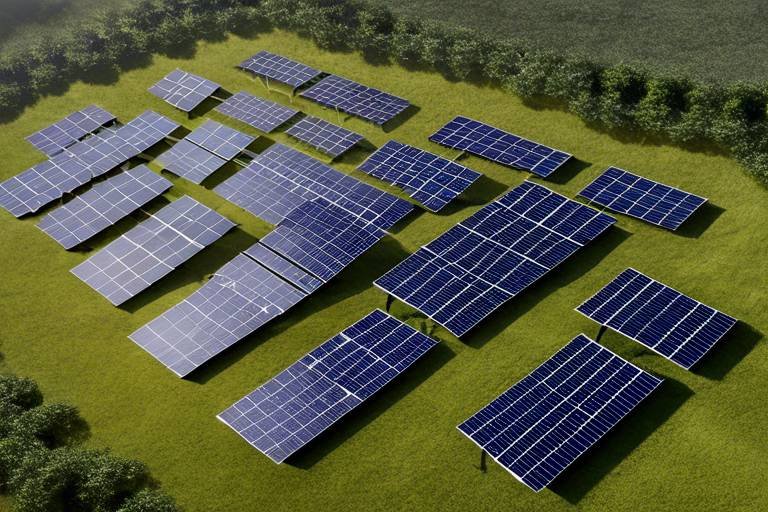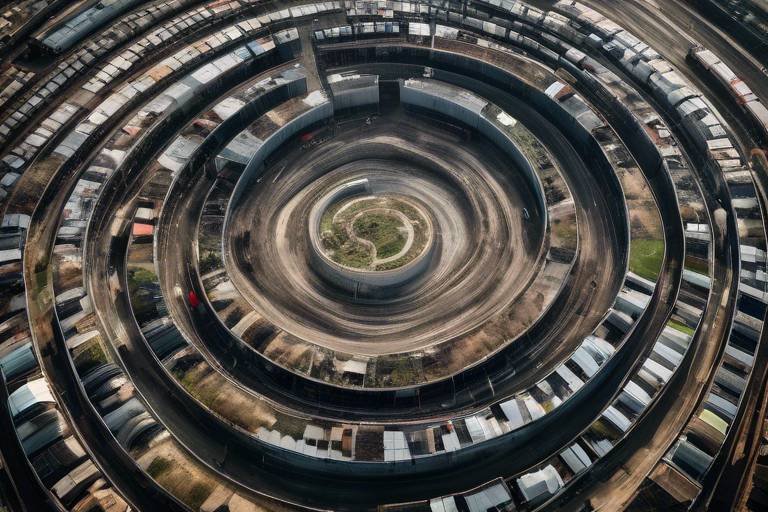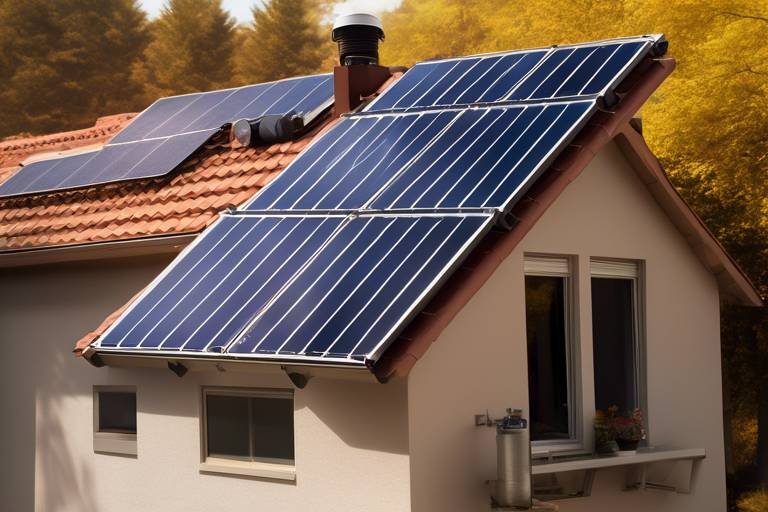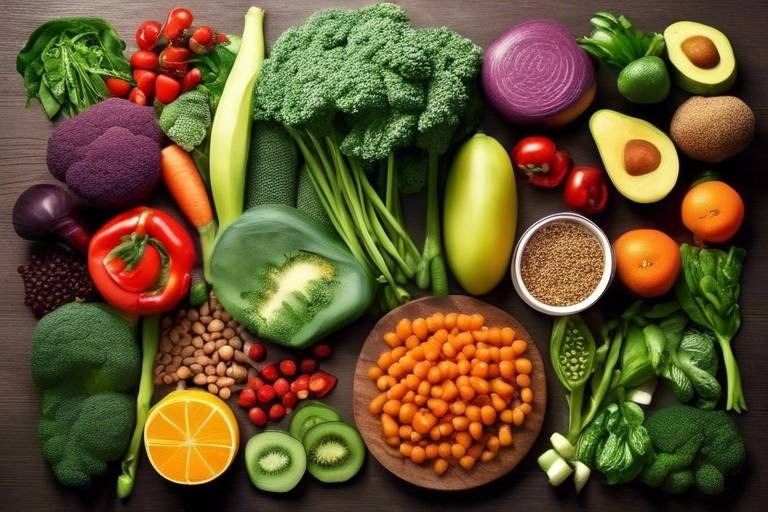How to Make Your Laundry Routine More Eco-Friendly?
In today's world, where environmental concerns are at the forefront, making your laundry routine more eco-friendly is not just a trend—it's a necessity. Imagine the impact we could have if everyone made small changes to their laundry habits! By adopting a few simple strategies, you can significantly reduce your carbon footprint while still keeping your clothes fresh and clean. So, how can you transform your laundry day from a chore into an eco-conscious endeavor? Let’s dive into some practical tips that will not only benefit the planet but also enhance your laundry experience.
Choosing the right detergent is crucial for an eco-friendly laundry routine. Many conventional detergents are loaded with harmful chemicals that can seep into our waterways, affecting aquatic life and, ultimately, our health. Instead, look for biodegradable options that break down naturally and are free from phosphates, dyes, and synthetic fragrances. These eco-friendly detergents are not just better for the environment; they can also be gentler on your skin, making them a win-win choice. When shopping, check the labels and opt for products that are certified by eco-labels, ensuring they meet strict environmental standards.
Water usage during laundry can be significant, contributing to the depletion of this precious resource. One of the easiest ways to reduce water consumption is by washing full loads. Did you know that washing a half-load uses nearly the same amount of water as a full load? So, wait until you have a full basket before hitting that start button! Additionally, consider investing in a washing machine that has a water-saving feature. These machines adjust the water level based on the load size, ensuring that you use only what you need. Other tips include:
- Using cold water whenever possible, as heating water consumes energy.
- Regularly checking for leaks in hoses and machines to prevent water waste.
Investing in energy-efficient washing machines and dryers can drastically reduce your carbon footprint. Look for appliances that are ENERGY STAR-rated; these machines are designed to use less water and energy than standard models. Not only will you be helping the environment, but you'll also notice a decrease in your utility bills. It’s like getting a two-for-one deal! The initial investment might be higher, but the long-term savings and benefits to the planet are well worth it.
Front-load washers are known for their efficiency and are often more eco-friendly than traditional top-load models. They use significantly less water—up to 50% less—because they rely on gravity to tumble the clothes rather than filling the tub with water. Additionally, they spin faster, which means your clothes come out drier and require less time in the dryer. This not only saves energy but also extends the life of your garments. If you're in the market for a new washing machine, consider making the switch to a front-loader!
Proper maintenance of your laundry appliances can enhance their efficiency and longevity. Regularly clean the lint filter in your dryer to improve airflow and reduce drying time. Additionally, consider descaling your washing machine every few months to keep it running smoothly. A well-maintained machine operates more efficiently, which means less energy consumption and a smaller environmental impact. Plus, it saves you from costly repairs down the line!
Drying clothes can consume a lot of energy, but there are several eco-friendly methods you can adopt. Air drying is one of the simplest and most effective ways to save energy. Just think about it—hanging your clothes on a clothesline or drying rack not only cuts down on energy usage but also leaves your laundry smelling fresh! If you live in a rainy area, consider using a drying rack indoors. You can even place it near a window to benefit from natural sunlight. Embrace the art of air drying, and you’ll be surprised at how much energy and money you save!
The choice of fabric plays a significant role in the environmental impact of laundry. Opting for sustainable fabric options, such as organic cotton, linen, or hemp, can make a big difference. These materials often require less washing and care, which means you can reduce your overall laundry frequency. Additionally, they are biodegradable, so when they do reach the end of their life, they won’t contribute to landfill waste. Think of it as investing in your wardrobe and the planet at the same time!
Synthetic fabrics, like polyester and nylon, can contribute to microplastic pollution when washed. Each time these materials go through the wash, tiny plastic fibers are released into the water system, harming marine life. To combat this, consider choosing alternatives that are kinder to the planet, such as natural fibers. If you must use synthetic fabrics, try washing them in a Guppyfriend bag, which captures microfibers and prevents them from entering the water supply.
Taking care of sustainable fabrics properly can prolong their life and reduce the need for frequent washing. Here are some tips to keep your eco-friendly wardrobe in top shape:
- Wash in cold water to save energy.
- Use a gentle cycle to minimize wear and tear.
- Avoid tumble drying; instead, air dry whenever possible.
By following these care tips, you can maintain the integrity of your garments while also being mindful of the environment.
1. What are eco-friendly detergents?
Eco-friendly detergents are biodegradable cleaning products that do not contain harmful chemicals, making them safer for the environment and your health.
2. How can I reduce water usage in my laundry?
You can reduce water usage by washing full loads, using water-efficient machines, and opting for cold water washes.
3. Are front-load washers really better for the environment?
Yes! Front-load washers use significantly less water and energy compared to top-load models, making them a more sustainable option.
4. What are some sustainable fabric options?
Sustainable fabric options include organic cotton, linen, hemp, and Tencel, which are all more environmentally friendly than conventional synthetic fabrics.
5. How can I care for my sustainable fabrics?
To care for sustainable fabrics, wash in cold water, use a gentle cycle, and air dry whenever possible to extend their life and reduce environmental impact.

Understanding Eco-Friendly Detergents
When it comes to making your laundry routine more eco-friendly, the first step often lies in choosing the right detergent. Traditional laundry detergents are packed with harsh chemicals that can be harmful not just to the environment but also to our health. These chemicals can seep into our waterways, affecting marine life and polluting our drinking water. So, what’s the alternative? Enter eco-friendly detergents! These products are formulated with biodegradable ingredients that break down naturally, minimizing their impact on the planet.
But wait, it’s not just about the ingredients! Eco-friendly detergents are also free from phosphates, optical brighteners, and synthetic fragrances. This is crucial because these additives can cause skin irritations and allergies, especially for those with sensitive skin. Imagine washing your clothes with a product that not only cleans but also cares for your skin and the environment. It’s like giving your laundry a warm hug!
Here are some key points to consider when selecting eco-friendly detergents:
- Biodegradable Ingredients: Look for products that list biodegradable components, ensuring they break down safely in the environment.
- Concentrated Formulas: Concentrated detergents require less packaging and can be more effective, meaning you use less per load.
- Plant-Based Options: Many brands offer plant-based detergents that avoid petroleum-based ingredients, which are harmful to the environment.
Additionally, consider the packaging of your detergent. Many eco-friendly brands use recycled materials or even offer refill stations to reduce plastic waste. It’s a small change that can make a big difference! By opting for these sustainable choices, you’re not only cleaning your clothes but also participating in a larger movement towards environmental responsibility.
In summary, understanding eco-friendly detergents is about more than just reading labels; it’s about making informed choices that align with your values. By selecting biodegradable and chemical-free options, you contribute to a healthier planet while still keeping your clothes fresh and clean. Remember, every small step counts, and your laundry routine can be a part of the solution!

Water Conservation Techniques
Water is one of our planet's most precious resources, and when it comes to laundry, the amount we use can really add up. Think about it: each time you throw in a load, you're not just washing clothes; you're also consuming gallons of water that could be saved with a few simple adjustments. So, how can you make your laundry routine more water-efficient? Let's dive into some practical techniques that will help you conserve water without sacrificing cleanliness or freshness.
First and foremost, always wash full loads. It might seem like a no-brainer, but many people make the mistake of washing small loads frequently. By waiting until you have a full basket, you can maximize the water used per wash. If you're worried about the clothes getting too wrinkled or mixed up, don't be! Modern machines are designed to handle larger loads, and your clothes will come out just as clean. Plus, you’ll be doing your part to reduce water waste.
Another effective method for conserving water is to use high-efficiency washing machines. These machines are designed to use less water and energy while still delivering excellent cleaning performance. In fact, they can use up to 40% less water than standard models. When shopping for a new washer, look for the ENERGY STAR label, which indicates that the appliance meets energy efficiency guidelines set by the U.S. Environmental Protection Agency. It's an investment that not only helps the environment but also saves you money on your utility bills in the long run.
Additionally, consider adjusting your washing habits by selecting the appropriate cycle settings. Many washing machines come with various cycles for different types of fabrics and soil levels. For lightly soiled clothes, you might not need to use the heavy-duty cycle, which typically consumes more water. Instead, opt for a quick wash or a gentle cycle that uses less water. This small change can significantly impact your overall water consumption.
It’s also worth exploring the idea of reusing laundry water. If you have a garden, consider using a greywater system to divert water from your washing machine to water your plants. Just be sure to use eco-friendly detergents that won’t harm your plants. This approach not only conserves water but also gives your garden a little boost!
Lastly, if you’re washing clothes by hand, you can also implement water-saving techniques. For instance, fill a basin or bucket instead of letting the water run continuously. This method allows you to control how much water you’re using and can lead to significant savings over time. Plus, it can be quite therapeutic to wash clothes by hand, connecting you more closely to your laundry routine.
In conclusion, conserving water during your laundry routine is not just about being eco-friendly; it's about being smart with the resources we have. By adopting these simple techniques, you can create a more sustainable laundry habit that benefits both your household and the environment. Remember, every drop counts!
- How much water does a typical washing machine use? Most traditional washing machines use between 30 to 40 gallons of water per load, while high-efficiency machines use about 15 to 30 gallons.
- Can I wash my clothes in cold water? Yes! Washing in cold water can save energy and is often just as effective for cleaning, especially with modern detergents designed for cold water.
- What is greywater, and how can I use it? Greywater is wastewater from sinks, showers, and washing machines. It can be reused for irrigation, but it's important to use biodegradable soaps and detergents to protect your plants.

Choosing Energy-Efficient Appliances
When it comes to making your laundry routine more eco-friendly, one of the most impactful choices you can make is investing in energy-efficient appliances. These machines not only help reduce your carbon footprint but also save you money on utility bills in the long run. If you're wondering why energy efficiency is crucial, think of it this way: every time you wash or dry your clothes, you're not just using water and detergent; you're also consuming energy that contributes to greenhouse gas emissions. By opting for appliances that consume less energy, you’re making a conscious decision to protect our planet.
One of the best ways to identify energy-efficient appliances is by looking for the ENERGY STAR label. This certification means that the appliance meets strict energy efficiency guidelines set by the U.S. Environmental Protection Agency. For instance, an ENERGY STAR-rated washing machine can use up to 25% less energy and 33% less water than standard models. Imagine the impact if every household switched to these efficient appliances! Not only would we see a significant decrease in energy consumption, but we’d also reduce water usage, which is vital in many regions facing drought.
Let's break down some key benefits of choosing energy-efficient appliances:
- Lower Utility Bills: While the initial investment might be higher, the savings on your electricity and water bills will quickly add up.
- Better Performance: Many energy-efficient machines come equipped with advanced technology that enhances cleaning performance, meaning your clothes come out cleaner and fresher.
- Longer Lifespan: These appliances are designed to be more durable, which means you’ll likely need to replace them less often, further reducing waste.
Moreover, energy-efficient appliances often feature advanced settings that allow you to customize your laundry cycles, ensuring that you’re using just the right amount of energy and water for each load. For example, some machines offer eco-friendly cycles that optimize water levels and energy usage based on the size of the load, making them a perfect fit for those who want to do their part in conserving resources.
To illustrate the difference in energy consumption, here’s a simple comparison table of typical energy usage between standard and ENERGY STAR-rated appliances:
| Appliance Type | Standard Model Energy Usage (kWh/year) | ENERGY STAR Model Energy Usage (kWh/year) |
|---|---|---|
| Washing Machine | 500 | 375 |
| Dryer | 800 | 600 |
As you can see from the table, switching to ENERGY STAR-rated appliances can lead to substantial energy savings. Not only is this beneficial for your wallet, but it also contributes to a healthier planet. In conclusion, when you're in the market for new laundry appliances, always prioritize energy efficiency. Your choices today can lead to a more sustainable tomorrow, making a real difference in the fight against climate change.
Q: What are some signs that I need to replace my old washing machine?
A: If your machine is making unusual noises, leaking, or not cleaning clothes effectively, it might be time for an upgrade. Additionally, if it’s over 10 years old, consider replacing it with a more energy-efficient model.
Q: How much can I save by switching to an energy-efficient dryer?
A: On average, you could save about $100 a year on your utility bills by switching to an ENERGY STAR-rated dryer, depending on your usage and local energy costs.
Q: Are energy-efficient appliances more expensive?
A: While the upfront cost may be higher, the long-term savings on energy and water bills often make them more economical over time.

Benefits of Front-Load Washers
When it comes to making your laundry routine more eco-friendly, one of the best decisions you can make is to switch to a front-load washer. These machines are not just a trend; they represent a significant leap in washing technology that benefits both your wallet and the planet. But what exactly makes them so special? Let's dive into the advantages that front-load washers bring to the table.
First and foremost, front-load washers are known for their energy efficiency. They typically use less water compared to traditional top-load models. This is because they operate on a tumbling mechanism that requires less water to clean your clothes effectively. In fact, a front-load washer can save up to 40% more water than a top-loader. Imagine the impact this can have on your water bill and the environment! Less water usage means less demand on our precious water resources, making it a win-win situation.
Another significant benefit of front-load washers is their energy savings. These machines generally use less electricity, primarily because they spin faster during the rinse cycle, removing more water from your clothes before they go into the dryer. This means your dryer doesn’t have to work as hard or run as long, ultimately saving you money on your energy bills. According to studies, switching to a front-load washer can reduce your energy consumption by around 50% compared to older models.
But wait, there’s more! Front-load washers are also designed to be gentler on fabrics, which means your clothes will last longer. The tumbling action is less abrasive than the agitator found in top-load washers, reducing wear and tear on your favorite garments. This longevity not only saves you money on replacements but also lessens the environmental impact associated with producing new clothing. In a world where fast fashion is the norm, every little bit helps!
Moreover, many front-load washers come with advanced features like steam cleaning and allergen removal cycles. These features not only enhance the cleaning process but also allow you to wash your clothes in a more effective manner, ensuring that they smell fresh and look great. If you’re someone who suffers from allergies, these washers can be a game-changer, making your laundry routine not just eco-friendly but also healthier!
In summary, the benefits of front-load washers are hard to ignore. They offer a combination of water and energy efficiency, gentle care for your clothes, and advanced cleaning features that make laundry day less of a chore. If you’re looking to make a positive change in your laundry routine, investing in a front-load washer might just be the best decision you can make!
- Are front-load washers more expensive than top-load washers? While the initial cost may be higher, the long-term savings on water and energy bills often outweigh the upfront investment.
- Do front-load washers require special detergent? Not necessarily, but using high-efficiency (HE) detergent is recommended for optimal performance.
- Can I wash bulky items like comforters in a front-load washer? Yes, many front-load washers have settings specifically designed for bulky items.

Maintaining Your Appliances
Proper maintenance of your laundry appliances is not just a chore; it's an essential step towards enhancing their efficiency and prolonging their lifespan. Think of your washing machine and dryer as the trusty steeds of your laundry routine; just like any hardworking companion, they need care and attention to keep galloping smoothly through your laundry days. Regular maintenance ensures that these machines operate at their best, minimizing energy waste and saving you money in the long run.
One of the first things you should do is to keep an eye on the lint filter in your dryer. A clogged lint filter can not only reduce the efficiency of your dryer but also pose a fire hazard. Cleaning it after every load is a simple yet effective way to maintain your appliance. Additionally, it’s a good idea to check the venting system periodically. Make sure it’s clear of obstructions, as this can significantly improve airflow and drying efficiency.
For washing machines, consider running a maintenance wash every few months. This involves running an empty cycle on the hottest setting, which helps to eliminate any detergent residue or odor-causing bacteria that may have built up inside. You can add a cup of white vinegar or baking soda to this cycle for an extra boost. Remember, a clean machine means cleaner clothes!
Another key aspect of maintenance is checking the hoses and connections regularly. Look for any signs of wear, such as cracks or leaks. Replacing old hoses can prevent potential water damage in your home and ensure that your machine operates efficiently. It's also wise to periodically check the drum for any foreign objects that might have slipped in during washes. You’d be surprised at what can end up in there!
Finally, don’t forget about the exterior of your appliances. A simple wipe-down with a damp cloth can prevent dust accumulation and keep your laundry area looking tidy. If your machines have a digital display, ensure that it’s clean and free from grime, as this can help you monitor settings more effectively.
By following these maintenance tips, you can ensure that your laundry appliances are not only performing at their peak but are also contributing positively to your eco-friendly laundry routine. Just like nurturing a plant, a little care goes a long way in keeping your appliances healthy and efficient!
- How often should I clean my washing machine? It's advisable to run a maintenance wash every 1-3 months to keep it clean and odor-free.
- What can I use to clean my dryer? Regularly clean the lint filter after every load, and consider using a vacuum to remove lint from the venting system every few months.
- Why is it important to check hoses and connections? Checking hoses can prevent leaks and water damage, ensuring your machine operates efficiently.
- Can I use vinegar to clean my washing machine? Yes, adding a cup of white vinegar during a maintenance wash can help eliminate odors and build-up.

Eco-Friendly Drying Methods
When it comes to drying your laundry, many people automatically reach for the dryer, but did you know that this can be one of the most energy-intensive parts of your laundry routine? Switching to not only helps the environment but can also save you money on your energy bills. Let's dive into some effective alternatives that can keep your clothes fresh and reduce your carbon footprint.
One of the simplest and most effective methods is air drying. This technique involves hanging your clothes outside on a clothesline or indoors on a drying rack. Not only does this method use zero electricity, but the sun also acts as a natural disinfectant, helping to eliminate odors and bacteria. Plus, the gentle breeze can help to fluff up your clothes, giving them that fresh, outdoor scent. If you're concerned about the weather, don't fret! Indoor drying racks are a fantastic option, and they can be placed near a window or in a well-ventilated room to maximize air circulation.
Another benefit of air drying is that it can extend the life of your garments. The high heat from dryers can cause fabrics to wear out faster, leading to pilling and fading. By choosing to air dry, you’re treating your clothes with a little more care, which can save you money in the long run by reducing the need for replacements.
For those who might be short on space or prefer a more compact solution, consider using a foldable drying rack. These racks are easy to set up and can fit in small areas like bathrooms or laundry rooms. Just hang your clothes on the rack and let them dry naturally. You can even place it near a heater during the colder months for an extra boost of warmth without the energy costs associated with a dryer.
Additionally, if you do need to use a dryer, there are ways to make it more eco-friendly. For example, using dryer balls can help to separate your clothes, allowing hot air to circulate more efficiently and reducing drying time. This not only saves energy but also minimizes wrinkles, meaning less ironing for you!
In summary, adopting eco-friendly drying methods is a simple yet impactful way to reduce your environmental footprint. Whether you choose to air dry your clothes or optimize your dryer usage, your choices can lead to a more sustainable laundry routine. Remember, every little bit counts, and making these small changes can contribute to a healthier planet.
- How does air drying save energy? Air drying uses no electricity, while traditional dryers consume a significant amount of energy.
- Will my clothes smell fresh if I air dry them indoors? Yes! If you air dry your clothes in a well-ventilated area, they will still smell fresh. Consider adding a few drops of essential oils to your wash for an added scent boost.
- Can I use a drying rack in winter? Absolutely! Just place it in a warm area or near a heat source to help speed up the drying process.

Choosing Sustainable Fabrics
When it comes to making our laundry routines more eco-friendly, one of the most significant factors to consider is the choice of fabrics. The clothes we wear can have a profound impact on the environment, not just in terms of how they're made but also how often they need to be washed. By opting for sustainable fabrics, we can significantly reduce our laundry frequency, leading to less water and energy consumption. Sustainable fabrics are typically made from materials that are either organic, recycled, or produced in a way that minimizes environmental harm. For instance, fabrics like organic cotton, hemp, and Tencel are not only biodegradable but also require less water and pesticides to grow, making them a far better choice for the planet.
It's essential to understand that the fabric you choose can dictate how often you need to wash your clothes. Some fabrics, like polyester or nylon, trap odors and stains more easily, leading to more frequent washing. In contrast, natural fibers such as wool and cotton tend to be more breathable and can resist odors, allowing you to wear them multiple times before they need a wash. This not only saves water but also extends the life of your garments. When shopping for clothes, look for labels that indicate the fabric is sustainably sourced or certified organic. This can help you make informed choices that align with your eco-friendly laundry goals.
Moreover, the impact of your fabric choice extends beyond just your own laundry routine. The production of synthetic fabrics is a significant contributor to microplastic pollution, which has devastating effects on marine life and ecosystems. When washed, these materials shed tiny plastic fibers that can end up in our oceans and waterways. By choosing alternatives like organic cotton or linen, you can help reduce this harmful cycle. Here’s a quick comparison table of common fabric types and their environmental impact:
| Fabric Type | Environmental Impact | Washing Frequency |
|---|---|---|
| Organic Cotton | Low impact, no pesticides | Infrequent, odor-resistant |
| Hemp | Very sustainable, requires little water | Infrequent, durable |
| Polyester | High impact, sheds microplastics | Frequent, odor retention |
| Tencel | Low impact, biodegradable | Infrequent, breathable |
In conclusion, by making conscious choices about the fabrics we wear, we can significantly reduce our environmental footprint. Sustainable fabrics not only help in decreasing the frequency of laundry but also contribute to a healthier planet. So, next time you shop, remember that your choices matter. Opt for fabrics that are not only kind to your skin but also to the Earth. Every small change counts, and together, we can make a big difference!
- What are sustainable fabrics? Sustainable fabrics are materials that are produced in a way that is environmentally friendly, often using organic or recycled materials.
- Why should I choose sustainable fabrics? Choosing sustainable fabrics can reduce your environmental impact by minimizing water usage, avoiding harmful chemicals, and decreasing microplastic pollution.
- How can I identify sustainable fabrics when shopping? Look for certifications like GOTS (Global Organic Textile Standard) or OEKO-TEX, which indicate that the fabric meets specific environmental and social criteria.

Impact of Synthetic Fabrics
When we think about our laundry, we often focus on the detergent we use or how we dry our clothes, but what about the fabrics themselves? The rise of synthetic fabrics like polyester, nylon, and acrylic has transformed the fashion industry, but these materials come with a hefty environmental price tag. One of the most pressing issues is microplastic pollution. Every time we wash synthetic fabrics, tiny plastic fibers break off and make their way into our waterways. In fact, it's estimated that a single load of laundry can release up to 700,000 microfibers into the environment.
These microplastics are not just a problem for our oceans; they can enter the food chain and ultimately affect human health. Marine life, mistaking these particles for food, ingest them, which can lead to various health issues for the animals and, subsequently, for humans who consume seafood. It's a vicious cycle that highlights the need for more sustainable choices in our wardrobes. Instead of reaching for that trendy polyester shirt, consider opting for natural fibers like organic cotton, hemp, or linen. These materials are not only biodegradable but also require less energy and water to produce, making them a win-win for both you and the planet.
In addition to the pollution caused by microfibers, synthetic fabrics are often treated with harmful chemicals during their production. These chemicals can leach into the environment, causing further damage to ecosystems. The production process itself is energy-intensive, contributing to greenhouse gas emissions and climate change. By choosing sustainable fabrics, you can significantly reduce your carbon footprint.
So, what can you do to minimize the impact of synthetic fabrics in your laundry routine? Here are a few suggestions:
- Limit synthetic clothing: Try to reduce the number of synthetic garments in your wardrobe.
- Wash less frequently: If your clothes aren't dirty, consider wearing them a few times before washing.
- Use a Guppyfriend bag: This specially designed laundry bag captures microfibers, preventing them from entering the water supply.

Care Tips for Sustainable Fabrics
When it comes to sustainable fabrics, taking care of them properly is essential to ensure they last longer and maintain their quality. After all, the longer your clothes last, the less often you have to replace them, which is a win for both your wallet and the environment. So, how do you keep these eco-friendly materials in tip-top shape? Let’s dive into some practical care tips that will help you extend the life of your sustainable fabrics.
First off, always check the care label before washing. This simple step can save you a lot of headaches. Different fabrics have different needs; some may require gentle cycles while others can handle a bit more agitation. For instance, organic cotton can usually withstand a regular wash cycle, while delicate fabrics like hemp might need a more tender touch. By following the manufacturer's instructions, you can avoid damaging your clothes and keep them looking fresh.
Next, consider washing in cold water. Not only does this method save energy, but it’s also gentler on your fabrics. Hot water can cause colors to fade and fibers to break down, especially in natural materials. Cold water washing is effective at removing dirt and odors while being kinder to the planet. Plus, you’ll notice a difference in your energy bill, which is a nice bonus!
Another tip is to reduce your washing frequency. With sustainable fabrics, you often don’t need to wash them as frequently as synthetic ones. For example, items made from wool or bamboo have natural antibacterial properties, which means they can be worn multiple times before needing a wash. This not only conserves water but also prolongs the life of your clothes. When you do wash, try to wash full loads instead of small ones; this maximizes water and energy efficiency.
When it comes to drying, air drying is your best friend. Not only does it save energy, but it also helps prevent shrinkage and maintains the integrity of your fabrics. If you have the space, consider setting up a clothesline or using a drying rack. If you must use a dryer, opt for a low heat setting to minimize damage. Remember, the less heat you expose your clothes to, the longer they’ll last.
Lastly, store your sustainable fabrics properly. This means keeping them in a cool, dry place away from direct sunlight, which can cause fading. Use breathable storage bags for seasonal items, and avoid overcrowding your closet. This will help prevent creasing and allow your fabrics to breathe, reducing the risk of mold and mildew.
By following these care tips, you’ll not only keep your sustainable fabrics looking their best, but you’ll also contribute to a more eco-friendly lifestyle. Remember, every small action counts when it comes to protecting our planet!
- What are sustainable fabrics? Sustainable fabrics are materials made from renewable resources that have a lower environmental impact compared to conventional fabrics. Examples include organic cotton, hemp, and Tencel.
- How often should I wash sustainable fabrics? You should wash them less frequently than synthetic fabrics. Many sustainable fabrics can be worn multiple times before needing a wash.
- Can I use regular detergent on sustainable fabrics? It's best to use biodegradable or eco-friendly detergents to maintain the integrity of the fabric and reduce environmental impact.
- Is air drying better for my clothes? Yes, air drying is gentler on fabrics, helps prevent shrinkage, and saves energy.
Frequently Asked Questions
- What are eco-friendly detergents?
Eco-friendly detergents are cleaning agents made from biodegradable ingredients that are less harmful to the environment. They avoid harsh chemicals that can pollute waterways and impact aquatic life, making them a safer choice for both your health and the planet.
- How can I conserve water while doing laundry?
To conserve water, always wash full loads instead of small ones. Additionally, consider using high-efficiency washing machines that use less water per cycle. You can also opt for shorter wash cycles when possible, which can help reduce overall water usage.
- What are the benefits of energy-efficient appliances?
Energy-efficient appliances, like those with the ENERGY STAR label, consume less electricity and water, which can significantly lower your utility bills. They also help reduce your carbon footprint, contributing to a more sustainable lifestyle.
- Why should I choose front-load washers over top-load washers?
Front-load washers are generally more efficient than top-load models. They use less water, require less energy to operate, and often provide better cleaning performance. Plus, they tend to be gentler on clothes, prolonging their lifespan.
- How can I maintain my laundry appliances?
Regular maintenance is key to keeping your appliances running efficiently. Clean the lint filter in your dryer after every use, and periodically check hoses and connections for leaks. Additionally, deep clean your washing machine every few months to remove any buildup that could affect performance.
- What are some eco-friendly drying methods?
Air drying is one of the best eco-friendly drying methods. You can use a clothesline or drying rack to let your clothes dry naturally, saving energy that would otherwise be used by a dryer. If you must use a dryer, consider using dryer balls to help reduce drying time.
- What fabrics are considered sustainable?
Sustainable fabrics include organic cotton, bamboo, hemp, and Tencel. These materials are often produced with less water and fewer chemicals, making them a better choice for the environment. They also tend to require less frequent washing, which further reduces their environmental impact.
- How do synthetic fabrics affect the environment?
Synthetic fabrics, like polyester and nylon, can contribute to microplastic pollution when washed. These tiny plastic particles can end up in oceans and waterways, harming marine life. Choosing natural or recycled alternatives can help mitigate this issue.
- What are some care tips for sustainable fabrics?
To care for sustainable fabrics, wash them in cold water and avoid using harsh detergents. Air drying is preferable, but if you must use a dryer, choose a low heat setting. Proper storage, like hanging or folding, can also help maintain their integrity and prolong their life.



















